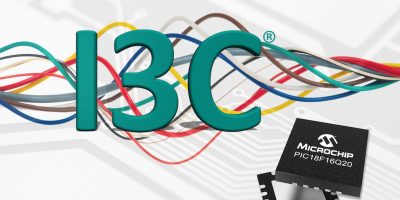PIC18-Q20 microcontroller has low pin count and I3C support
Improved Inter Integrated Circuit (I3C) is rapidly becoming a more sustainable solution for interfacing sensors with a high data rate, said Microchip. The company has introduced the PIC18-Q20 microcontroller product line which has up to two I3C peripherals, is space-efficient and interfaces with devices operating in multiple voltage domains.
The PIC18-Q20 family of microcontrollers is claimed to be the industry’s first low pin count MCUs with up to two I3C peripherals and multi-voltage I/O (MVIO). They are available in 14- and 20-pin packages with dimensions as small as 3.0 x 3.0mm. The compact microcontrollers are designed for real-time control, touch sensing and connectivity applications. They offer configurable peripherals, advanced communication interfaces and easy connection across multiple voltage domains without external components.
They combine I3C functionality, flexible peripherals and the ability to operate on three independent voltage domains, which makes them suitable for use with a primary microcontroller in a larger overall system. The microcontrollers can process sensor data, handle low latency interrupts and report on system status, while the central processing unit (CPU) runs at a different voltage domain. The I3C peripheral operates from 1.0 to 3.6V.
These low power, small form factor microcontrollers can be used in a range of space-sensitive applications and markets including automotive, industrial control, computing, consumer, IoT and medical.
“One of the main barriers to large-scale IoT adoption is the cost of implementing an edge node,” said Greg Robinson, corporate vice president of Microchip’s 8-bit MCU business unit. “By introducing the industry’s first low pin count MCU with I3C we are enabling flexible, cost-effective scaling of IoT applications and embracing the new standard communications interface,” he said.
Compared to I2C, I3C offers higher communication rates and lower power consumption, all while maintaining backward compatibility with legacy systems. Microchip said the I3C and MVIO functionality, combined with its configurable Core Independent Peripherals (CIPs), allow for lower system costs, reduced design complexity and a reduction in board space by replacing external level shifters with on-chip multiple voltage domains.
The PIC18-Q20 family is supported by Microchip’s development ecosystem of hardware and software tools, including its MPLAB X and MPLAB Xpress Integrated Development Environments (IDEs) and MPLAB Code Configurator (MCC)
Developers can get a quick start in evaluating I3C and MVIO capabilities on the PIC18-Q20 using Microchip’s PIC18F16Q20 Curiosity Nano evaluation kit which is a compact, cost-effective development board for rapid prototyping.




